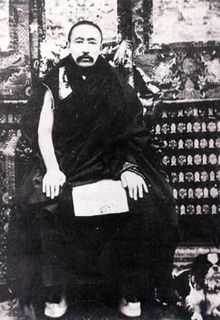Thubten Choekyi Nyima, 9th Panchen Lama

| Part of a series on |
| Tibetan Buddhism |
|---|
 |
|
Practices and attainment |
|
History and overview |
|
Thubten Choekyi Nyima (Tibetan: ཐུབ་བསྟན་ཆོས་ཀྱི་ཉི་མ་, Wylie: Thub-bstan Chos-kyi Nyi-ma, ZYPY: Tubdain Qoigyi Nyima ) (1883 – 1937), often referred to as Choekyi Nyima, was the 9th Panchen Lama of Tibet.
In 1901, Choekyi Nyima was visited by the Mongolian Lama, Agvan Dorzhiev. Although he only stayed for two days at Tashilhunpo, Dorzhiev received some secret teachings from the Panchen Lama, as well as readings of the Prayer of Shambhala, written by Lobsang Palden Yeshe, the sixth (or third) Panchen Lama, concerning the Buddhist kingdom of Shambhala, which were of great importance to Dorzhiev's developing understanding of the Kalachakra ('Wheel of Time') tantric teachings. Choekyi Nyima also gave Dorzhiev gifts including some golden statues.[1]
In 1906, Sir Charles Alfred Bell, was invited to visit the 9th Panchen Lama at Tashilhunpo, where they had friendly discussions on the political situation.[2]
He fled to Inner Mongolia, China in 1924 after a dispute with the thirteenth Dalai Lama when he sensed that he might face threat after his own monastery’s monks were prohibited from holding any office in the Central Tibetan government and his officials were locked up in Lhasa.[3] Among the Mongols, the 9th Panchen Lama became a well liked figure.[4] The Dalai Lama was attempting to collect revenue from the Panchen Lama's estate to cover a fourth of Tibet's military expenses, and to reduce the power of the Panchen Lama, who at the time enjoyed rule over an effectively autonomous region around Shigatse.[5]
In China, the ninth Panchen Lama worked on plans to develop Tibet along modern lines.[6] He also held a position in the Mongolian and Tibetan Affairs Commission.
The Panchen Lama was considered extremely "pro Chinese".[7][8][9]
Choekyi adopted the ideas of Sun Yatsen like the Kham revolutionary Pandatsang Rapga.[10] It has been suggested he read the works of Sun Yatsen which were translated by Rapga.[11]
In 1937, he died in Gyêgu (Tibetan: Jyekundo; Chinese: Yushu) in Qinghai Province.
The tombs of the fifth through the ninth Panchen Lamas were destroyed during the Cultural Revolution and have been rebuilt by the tenth Panchen Lama with a huge tomb at Tashilhunpo Monastery in Shigatse, known as the Tashi Langyar.[12]
Notes
- ↑ Snelling 1993, pg. 77
- ↑ Chapman 1940, pg. 141
- ↑ Tuttle 2006
- ↑ Znamenski, Andrei (2011). Red Shambhala: Magic, Prophecy, and Geopolitics in the Heart of Asia (illustrated ed.). Quest Books. p. 35. ISBN 0835608913. Retrieved 24 April 2014.
- ↑ Powers 2004, pg. 99
- ↑ Jagou, pp. 156-159, 206-208
- ↑ Chinese Materials Center (1982). Who's who in China, 1918-1950: 1931-1950. Volume 3 of Who's who in China, 1918-1950: With an Index, Jerome Cavanaugh. Chinese Materials Center. p. 194. Retrieved 2011-06-07.
- ↑ The China weekly review, Volume 54. Millard Publishing House. 1930. p. 406. Retrieved 2011-06-07.
- ↑ China monthly review, Volume 56. Millard Publishing Co., inc. 1931. p. 306. Retrieved 2011-06-05.
- ↑ Gray Tuttle (2007). Tibetan Buddhists in the Making of Modern China (illustrated ed.). Columbia University Press. p. 153. ISBN 0-231-13447-9.
- ↑ Gray Tuttle (2007). Tibetan Buddhists in the Making of Modern China (illustrated ed.). Columbia University Press. p. 152. ISBN 0-231-13447-9. Retrieved 2011-12-27.
- ↑ Mayhew 2005, pg. 175.
See also
- Yangsanjab, Mongol prince who hosted Lama's Ceremony
References
- Chapman, Spencer. Lhasa: The Holy City (1940) Readers Union Ltd., London.
- Jagou, Fabienne . Le 9e Panchen Lama (1883-1937): Enjeu des relations Sino-Tibetaines
- Mayhew, Bradley and Kohn, Michael. Tibet 6th Edition (2005) Lonely Planet Publications. ISBN 1-74059-523-8
- Powers, John. History as Propaganda: Tibetan Exiles versus the People's Republic of China (2004) Oxford University Press. ISBN 978-0-19-517426-7
- Snelling, John. Buddhism in Russia: The Story of Agvan Dorzhiev : Lhasa's Emissary to the Tsar (1993) Element Books. ISBN 1-85230-332-8
- Tuttle, Gray. Review of Le 9e Panchen Lama (1883-1937): Enjeu des relations Sino-Tibetaines, JIATS, no. 2 (August 2006) Columbia University. THDL #T2726
| Preceded by Tenpe Wangchuk |
Reincarnation of the Panchen Lama | Succeeded by Choekyi Gyaltsen |
| |||||||||||||